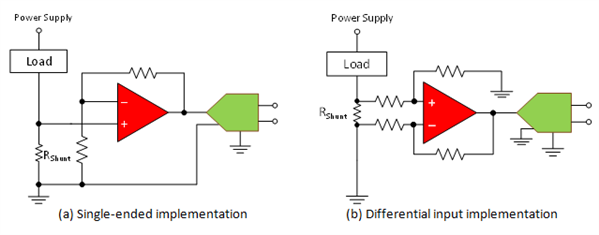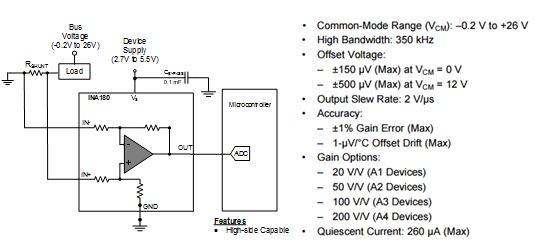SSZTA51 June 2017 INA180 , INA181
Measuring current may sound like a simple task, but it is not as easy as it sounds. Current can’t be sensed directly; however, it is related to other measureable parameters that you can sense directly, such as voltage and magnetic field density.
In general, there are two ways to measure current. The first is by measuring the magnetic field density generated around a current-carrying conductor. This method is suitable when you require noninvasive current measurements, but you’ll need to justify its relative high cost and complex implementation. The second is to use a small shunt resistance and measure the differential voltage across it that results from the current flow, a direct implementation of Ohm’s law. This method is common due to its high accuracy and low implementation costs. Figure 1 shows the two different methods and underlying physics behind each.
 Figure 1 Current-sensing Methods and
Their Underlying Physics
Figure 1 Current-sensing Methods and
Their Underlying PhysicsIn this blog post, I will discuss the resistive-based method that utilizes Ohm’s law across different implementations and present some of their system benefits and tradeoffs.
Depending on the application and use of the current to be measured (protection, system monitoring or control), you can place the shunt resistor either between the supply and the load or between the load and ground. The first placement is called high-side sensing (sensing the current entering the load), while the second placement is called low-side sensing (sensing the current leaving the load). Table 1 summarizes those two approaches.
| High-side sensing | Low-side sensing | |
|---|---|---|
| Implementation | Differential input | Single or differential input |
| Ground disturbance | No | Yes |
| Common voltage | Close to supply | Close to ground |
| Common-mode rejection ratio (CMRR) requirements | Higher | Lower |
| Can detect load shorts? | Yes | No |
Many engineers choose low-side sensing for cost-sensitive applications. Figure 2a shows the most common approach, using a single-ended operational amplifier (op amp). This approach is easy and inexpensive to implement; however, the main trade-off here is accuracy. With this method, parasitic resistances and the temperature coefficients of the resistive gain network will significantly affect accuracy. You can read more about these errors by looking at the 50mA-20A Single-Supply, Low-Side or High-Side Current Sensing Solution precision reference design and TI TechNote, “External Current Sense Amplifiers vs. Integrated On-Board Amplifiers for Current Sensing.”
 Figure 2 Main Low-side Op Amp
Implementations for Current Measurements
Figure 2 Main Low-side Op Amp
Implementations for Current MeasurementsAnother pitfall is that you can’t detect load short faults. You can mitigate the accuracy issues related to ground disturbance and parasitics by using the differential configuration shown in Figure 2b. Accuracy will still be limited by the CMRR and drift of the solution, which are a function of the op amp and the matching of the gain resistors. The better the CMRR and drift, the higher the cost of the solution.
To overcome these issues, TI introduced dedicated current-sensing solutions. The INA180 family of devices is a great example that offers high accuracy for cost-sensitive applications. The INA180 family features a high 350kHz closed-loop bandwidth and a fast 2V/µs slew rate that enable their use in applications such as constant current regulators, power supplies, and motor drives, which benefit from such features. Figure 3 shows the basic application diagram of the INA180 with some key specifications.
 Figure 3 INA180 Basic Application
Diagram and Key Features
Figure 3 INA180 Basic Application
Diagram and Key FeaturesA current-sensing location varies depending on the application and intended use of the measured current. Low-side sensing is preferable for cost-sensitive applications that can tolerate ground disturbances and load shorts. High-side sensing is preferable when ground disturbances cannot be tolerated and load-short detection is required. Traditional discrete implementations compared to dedicated current sensors tend to have limited accuracy, a bigger solution footprint and a relatively higher cost for the same accuracy level. High-side sensing addresses the issues of load short detection and the need to eliminate ground disturbance. The main challenge is the high common-mode voltage that the amplifier needs to tolerate. This challenge, in addition to the accuracy challenges of discrete implementations and cost trade-offs, pushes design engineers to consider other solutions. Again, dedicated current sensors are the perfect solution because they offer high accuracy, low cost and a high common-mode voltage. The INA180 is another great solution for high-side sensing, as the common-mode voltage of the device can go up to 26V.
The INA180 offers a great combination of performance, solution size and design flexibility at the right price point for cost-sensitive applications that are well suited for the main drivers for new electronic devices – cost, performance and size. To get posts like this delivered to your inbox, sign in and subscribe to Analog Wire.
Additional Resources
- Learn more about TI’s portfolio of current-sense amplifiers.
- Get started with the Current Sense Amplifiers video training series.
- Read these TI TechNotes: